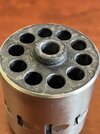Tallinar
Member
So, this question is purely academic, and probably has no practical bearing, but I'm curious anyway.
I had a thought as I was cleaning my Single Ten the other day after putting several hundred lead rounds through it without a thorough cleaning (I often just do a superficial cleaning with a CLP after a short range trip, and only break out the Hoppe's periodically to clean several guns at once).
As lead splatter occurs when shooting a revolver, and lead fouling begins to accumulate on the face of the cylinder over many, many rounds, the cylinder gap -- at least conceptually -- begins to "shrink" due to the added material. Does this mean that with enough shooting and not cleaning the face of your cylinder, lead fouling could conceptually increase the relative velocity of subsequent rounds fired from a revolver?
I feel like a kid trying to make an argument to his mother why he shouldn't wash behind his ears.

I had a thought as I was cleaning my Single Ten the other day after putting several hundred lead rounds through it without a thorough cleaning (I often just do a superficial cleaning with a CLP after a short range trip, and only break out the Hoppe's periodically to clean several guns at once).
As lead splatter occurs when shooting a revolver, and lead fouling begins to accumulate on the face of the cylinder over many, many rounds, the cylinder gap -- at least conceptually -- begins to "shrink" due to the added material. Does this mean that with enough shooting and not cleaning the face of your cylinder, lead fouling could conceptually increase the relative velocity of subsequent rounds fired from a revolver?
I feel like a kid trying to make an argument to his mother why he shouldn't wash behind his ears.



